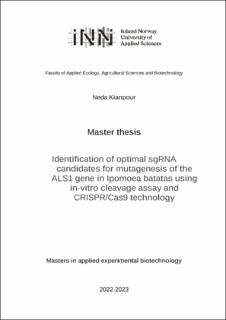| dc.description.abstract | Plant genome editing, a transformative technology in agriculture and biotechnology, faces challenges in efficiently delivering CRISPR/Cas components. Current methods, including Agrobacterium-mediated delivery, particle bombardment, and PEG-mediated protoplast transformation, have limitations due to random plasmid DNA integration and unpredictable genetic expression. As a solution, there's a growing interest in developing gene-edited lines with reduced foreign genetic integration risk using DNA-free delivery methods like RNP complexes (pre-assembled ribonucleoprotein) or transient plasmid DNA expression. Hence, this study aimed to create tools for CRISPR/Cas9-based gene editing in Ipomoea batatas (sweet potato) by targeting the ALS1 gene as a reliable null-mutant phenotype. The focus was designing and evaluating optimal sgRNA candidates for CRISPR/Cas9 RNP-based genome editing. Additionally, the performance characteristics of an engineered recombinant Cas9 with those of a commercially available Cas9 were aimed to be compared. Firstly, the selection of target plasmids DNA, PCR_IbALS1_S1.1 and PCR_IbALS1_S4.1, represented the specific genomic region of interest (ALS1 gene) in Ipomoea batatas among four plasmids DNA. Then, five distinct sgRNAs were designed based on coding sequences and evaluated through in-vitro cleavage assays. The findings demonstrated effective cleavage by SpCas9 guided by a single sgRNA (FP_IVT_T7_Spa2_S1.1) in the complementary DNA sequence of plasmid DNA PCR_IbALS1_S1.1. Efforts were made to create in-vitro recombinant Cas9 protein through expression vector construction, primer designing, in-fusion cloning, and PCR. However, this endeavour yielded no product, primarily attributed to the substantial size of the insert fragment (CDS of Cas9 and NLS ~ 9849 bp). Thus, this study has laid the foundation and provided fundamental insights for future in-vitro ALS1 CRISPR/Cas9-based genome editing using RNP complexes in Ipomoea batatas, despite the challenges encountered and the outcome. | |
